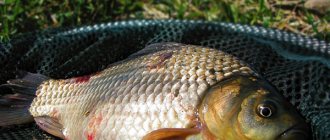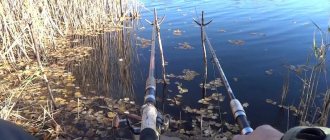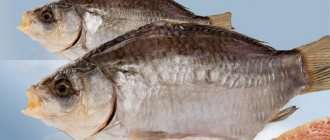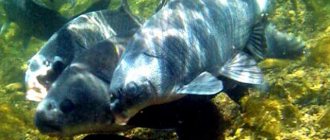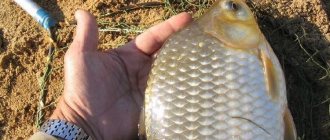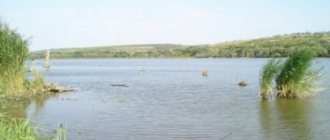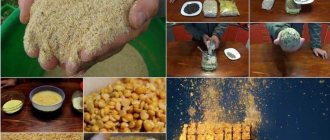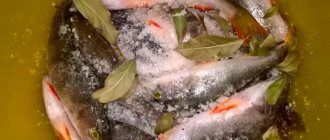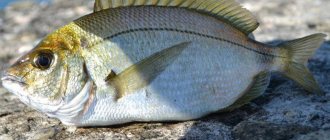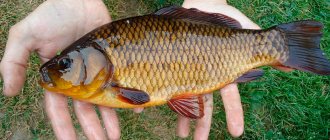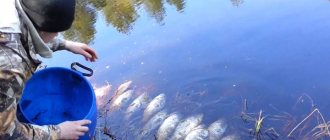Author of the article
Andrey Soprykin
Professional fisherman with 23 years of experience.
Articles written
85
When purchasing crucian carp at the market or in a store, many make a choice based on the size of the fish. Therefore, it is not surprising that many fish farmers. Those who specialize in breeding or fishing are interested in how quickly crucian carp grows?
The size and actual lifespan of crucian carp directly depends on a large number of parameters, and if you do not pay attention to at least one factor when breeding or searching for a suitable reservoir with “large fish,” you may be unpleasantly surprised due to the small weight/height of the individuals.
Crucian carp belongs to the carp family. It lives mainly in fresh water bodies of the CIS countries, Russia and Europe. Any fisherman would be happy to catch this fish.
Information for the fish farmer
It is worth noting that crucian carp cannot get along with everyone in a pond. That is why an experienced fish farmer, before breeding with his own hands, needs to have a sufficient theoretical basis to provide the fish with optimal conditions.
Among other things, natural growth will be influenced by what specific time of year to start breeding. Among the main points of this process, the following should be noted:
- there are practically no requirements for the external environment;
- You can take any body of fresh water as a basis;
- crucian carp has excellent adaptation capabilities;
- the fish quickly adapts to changes in temperature;
- eats natural food in water bodies;
- this species is resistant to many aquatic diseases;
- fish is suitable for organizing a profitable business.
Crucian carp can be crossed, for example, with carp, which will ultimately produce an even larger cross. It's no secret that this species has high immunity.
The main problem during breeding is the relatively small weight of males when compared with females. Because of this unique feature of this species, an experienced fish farmer introduces carp into the water during breeding, determining the required number of fish that is required to obtain an improved species.
Expert opinion
Valery Andreevich Sizov
Professional fisherman with 35 years of experience
Attention! It is necessary to control the size of female and male fish of different species so that they have dimensions close to each other. In this case, the offspring will actively gain weight and size.
Growth based on variety
How quickly crucian carp grows is largely due to its appearance. There are only 3 types:
- Gold fish.
- Gold.
- Silver.
The first type is an aquarium fish. The rest can be found in reservoirs throughout the Russian Federation.
Golden carp
As for habits, it is no different from its silver counterpart. One of the differences is the color of its scales - it has a golden color.
Expert opinion
Valery Andreevich Sizov
Professional fisherman with 35 years of experience
This is interesting!!! Among other things, among the differences we can also note the fins of a dark brown hue.
Moreover, it is the fin that is the main difference, since it is not uncommon for silver crucian carp to have scales exactly the same color as gold carp, which is why they are often confused.
The golden subspecies can be seen much less frequently than the silver one. Under the most favorable conditions, this subspecies can grow up to 0.5 m in length and more than 3 kg in weight.
Goldfish
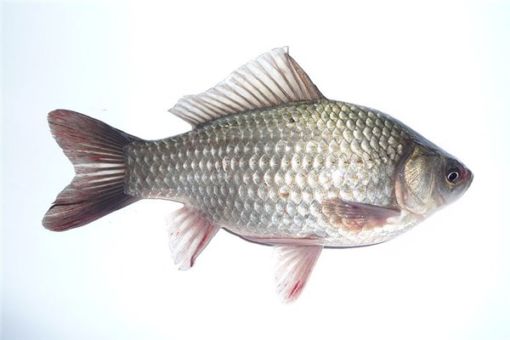
It is noteworthy that crucian carp can be silver not only with a silver shade of scales, but also with others, including a golden or even orange shade.
This species has a typical difference from the golden one in the structure of its fins. Their first ray consists of a hard, jagged spine. The scales are quite large and the body is quite tall.
Reproduction of this species occurs much faster. If we talk about natural living conditions, it reaches a maximum weight of up to 2 kg and no more than 0.4 m. In the most favorable conditions, which are not found in the natural environment at all, this subspecies can reach up to 5 kg.
How long does goldfish live?
This is a fish that people love to catch in our latitudes, including for its external beauty.
The golden scales shine so pleasantly in the sun that the pleasure from the catch doubles. And usually golden crucian carp is caught at 3-4 years of age, when it is not yet experienced. Although if the feeder is not greedy, carefully fishes out and releases small prey so that it still gains weight, the fish can plow the waters for up to 5-7 years (on average). If it is never caught, the maximum lifespan of a goldfish reaches 12-15 years
. During this time, it can grow up to 0.5 meters and gain up to 5 kilograms of weight. Just keep in mind that already with a mass of 0.5-1 kilograms, the fish can very actively resist fishing.
Accommodation preferences
It is known that this species can survive in water where other individuals are not capable of growth. For fish, the level of acidity, oxygen, and even the amount of natural food in a reservoir is not very important, which is why it can be found in small swampy places, where it can survive even the most severe Russian winter.
In general, the fish feels great in still water, but according to many fishermen, crucian carp can also be found in flowing water, but there it tries to stay as close to the very bottom as possible. As for gold, it is generally difficult to find in running water.
Expert opinion
Valery Andreevich Sizov
Professional fisherman with 35 years of experience
Important! The best option for crucian carp to live and grow is a stagnant lake with well-grown vegetation, which is both a shelter and a source of food.
Fishermen find it even in waters where, at first glance, there may seem to be no life at all. This is due to the fact that crucian carp prefers to hide in the muddy bottom, where it remains there if the reservoir dries out or freezes. It was the golden crucian carp that especially distinguished itself in this, having greater vitality.
Even the presence of a small current has a negative impact on this species. This is due to the unique shape of the body, which cannot constantly resist the flow, which requires a lot of energy.
It will not be possible to find it in places where there is sand or stones at the bottom. This is due to the fact that in such waters there is no natural type of food that is necessary for crucian carp. Among its menu you can find small arthropods, plankton, organic particles that can be found in the mud and small worms.
Crucian carp reproduce most quickly in overgrown and swampy places, where they may be practically the only species of fish.
A particularly great threat to fish is posed not by fishermen, but by natural predators who can easily cope with the clumsy crucian carp. Problems can arise even for young animals in a reservoir without predators, because fry, larvae and eggs are actively eaten by frogs, which also prefer to live in the same places that crucian carp like.
Cooking methods
Crucian carp meat does not lose its delicate texture after any heat treatment, except smoking and drying, so the fish can be baked, stewed, fried, boiled, etc.
How to bake the whole thing in the oven?
Using the oven, you can deliciously bake crucian carp whole or in pieces. Small and medium-sized carcasses up to 2 kg can be cooked including the head, but large crucian carcasses weighing more than 2 kg are best cut into portions, otherwise the meat may not be cooked completely.
It is correct to bake crucian carp at a temperature of 180 to 200 degrees, and it is recommended to cover the baking sheet with foil so that the skin of the fish does not burn. The foil should be removed 10 minutes before the dish is ready.
Cooking time depends on the serving size, but on average ranges from 25 to 35 minutes. To speed up the process, you can pre-fry the fish in a hot frying pan on both sides for 3 minutes.
Before baking, it is recommended to marinate the carcass in spices and lemon juice and, if desired, stuff the abdominal cavity with vegetables, for example, fried onions with carrots, sour cream or mayonnaise.
How to fry in a frying pan?
It is correct to fry crucian carp in a well-heated frying pan with a small amount of vegetable oil. It is also advisable to use a breading of flour or crackers to get a delicious golden brown crust.
Small carcasses can be fried whole, including the head (but without gills), and large crucian carcasses can be cut into pieces 3-4 cm thick.
To avoid feeling the bones, before cooking, shallow diagonal cuts should be made on the whole carcass or pieces of fish at a distance of approximately 3-5 mm from each other. Then, due to the high temperature, the bones will become soft and will not be felt when eating fish.
In terms of time, you need to fry the crucian carp for 5-10 minutes on each side (until a uniform crust forms). The time depends on the thickness of the pieces or the size of the whole crucian carp.
When frying a whole carcass, the abdominal cavity can be filled with caviar, lemon and spices that remain after preliminary marinating.
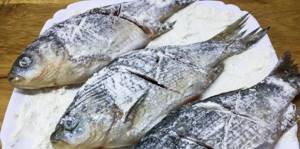
How to put it out?
Crucian carp can be stewed with vegetables in tomato juice. To do this you should:
- clean the fish, cut into pieces of approximately the same thickness, marinate;
- chop the vegetables and fry in vegetable oil until they become soft;
- Place the pieces of crucian carp in a deep container, the bottom of which is greased with vegetable oil;
- put fried vegetables on top, pour tomato juice;
- add spices to taste;
- simmer the fish for 40-60 minutes over low heat with the lid closed.
You can make several slanted cuts on each piece so that the bones are less noticeable after cooking.
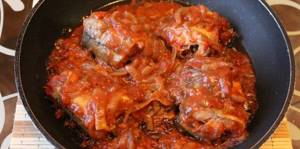
How to cook?
The carcass should be cleaned, removed from the entrails, fins and head (or gills with eyes). Then make several cuts on the back and sides to cut out the small bones.
Before you start cooking crucian carp, it is best to marinate the carcass in a salt solution to get rid of the muddy smell that will appear after cooking.
The carcass or pieces of fish should be placed in a pan with cold water (the liquid should completely cover the product). Next, you should move the container to the stove, add salt, allspice, a little vegetable oil and cover the pan with a lid.
When the water starts to boil, reduce the heat to low and continue cooking the fish for 15 minutes. A couple of minutes before the end of cooking, you can add herbs to the water (for flavor).
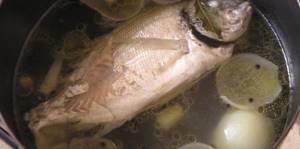
How to steam in a slow cooker?
Before cooking, the carcass must be cleaned of scales, fins, entrails and gills. You can cook whole or chopped fish, but in any case you need to make inclined cuts on the surface of the crucian carp, and then marinate it in spices and lemon juice.
Pour a liter of water into the multicooker bowl, add bay leaves, dried herbs or peppercorns. Then transfer the fish to a special container and place in the slow cooker. You can put a sprig of dill or parsley on the crucian carp, and then close the lid.
Cook on the “Steam” mode for 20 minutes.
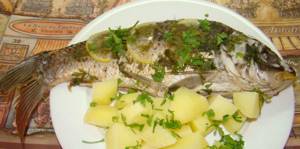
How to make it in the microwave?
Using a microwave oven, it is better to bake crucian carp in pieces rather than the whole carcass, as the meat may not bake evenly.
To prepare you need:
- cut the cleaned carcass into pieces 2-3 cm thick;
- rub the fish with salt, garlic passed through a press, sprinkle with lemon juice and leave for 15 minutes;
- brush the pieces with sour cream and place in a baking bag;
- place the fish in a single layer on a plate (if possible with the back to the edge of the plate);
- turn on the microwave at full power for 10 minutes;
- turn the slices over to the other side and turn on the device for another 5-10 minutes.
The baking time for crucian carp depends on the size of the fish and the power of the microwave oven.
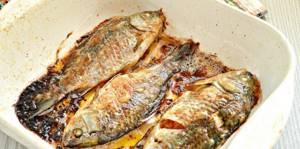
How to cook in an air fryer?
To prepare crucian carp, you need to clean the fish from scales, giblets, and also remove the head and all fins. Then rinse the carcass thoroughly under running water, dry it, cut into pieces or make oblique cuts on the sides, rub the surface with spices to taste, including salt, and leave the fish for 10-15 minutes.
After the crucian carp you need to coat it with sour cream or mayonnaise, put onion rings mixed with mayonnaise and herbs into the abdominal cavity. Next, the carcass should be moved to foil and rolled into an envelope.
Place the workpiece on the air fryer grill, set the temperature to 260 degrees with high ventilation for 40 minutes. 10 minutes before the end of cooking, the foil should be opened so that a golden brown crust appears on the fish.
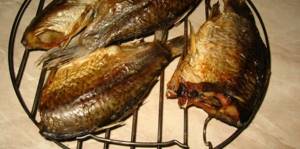
How to pickle?
Small carcasses of crucian carp can be quickly salted at home, since it is permissible to leave the fish ungutted. To do this, it is enough to remove the mucus from the surface of the carcasses and remove the gills. Then you need to rub each fish with salt, and then put it in a container in layers, alternating with coarse salt, press it down with a board and set the press for 5 days.
To salt large specimens (weighing more than 1 kg), you need to remove the giblets and also make a deep cut along the entire back (almost to the ridge). Next, the fish also needs to be rubbed with salt, pouring a little into the abdominal cavity, incision and head, and then folded in layers in a wooden box, alternating with layers of coarse salt. Cover the box with wood and install the press. Leave for 5 days.
For proper salting of crucian carp, suitable for both drying and drying, you need to use 1.5 kg of salt per 10 kg of fish.
The box and container with fish should be in a cool, dark place with good air ventilation.
For hot smoking, it is easy to salt the fish. To do this, just generously rub the carcass with salt, as well as any other spices (not forgetting the cleaned belly if the fish is gutted), cover with foil and leave in a cool place for 1-3 hours (depending on the size of the carcass).
How to dry it?
After pre-salting the crucian carp at home, which is described above, you need to shake off the excess salt and rinse the carcass under running water. Then it will be correct to dry the fish a little: you can blot the carcass with a napkin or leave it on the table for a while.
Next, after threading the rope through the head, you need to hang the fish in a dark and ventilated place, cover with gauze or a bandage and leave to dry for 5 to 7 days, depending on the size of the carcasses.
It is better to place paper or a container under the crucian carp, as excess moisture and fat will drain from the fish.

How to wilt?
To wilt crucian carp deliciously, it must be properly soaked after salting. To do this, rinse each carcass under running water and then immerse it in cold water for 2-3 hours. Next, you need to transfer the fish to a colander to drain off excess moisture, and then wipe the carcass with a napkin.
To prevent flies from sticking to the crucian carp, you can not use gauze, but sprinkle the fish with sunflower oil. Next, the carcass needs to be hung in a dark but warm room with good air circulation.
In terms of time, drying at home takes from 5 days for small fish and up to 15 days for large crucian carp.
How to smoke?
Crucian carp can be smoked whole (not gutted), but with the gills removed. The fish must initially be marinated or salted (as described above), and then smoked in a special smokehouse using a hot (fast) or cold (slow) method.

Hot way
Preparing the fish:
- after salting or marinating in liquid brine, the carcasses must be removed and thoroughly washed under running water;
- then dry the crucian carp or wipe it with a napkin;
- then hang the fish in the open air for 1 hour so that it dries a little.
Place a thin layer of wet alder chips or cherry branches sprinkled with water on the bottom of the smokehouse. Place a tray on top of the wood chips so that the fat from the fish does not drip down and spoil the smell of smoke.
If the fish is large and its belly has been gutted, the carcass should be placed cut side up on the smokehouse grate. Then you need to close the lid and move the smokehouse to the fire.
Smoking time ranges from 20 to 40 minutes depending on the size of the fish. There is no need to open the lid during cooking, but open it immediately after cooking. You need to remove the crucian carp from the smokehouse after they have cooled down a little.
Cold way
This smoking method is longer and more labor-intensive. Consists of the following stages:
- after salting, the carcasses need to be rinsed from salt and placed in a container with cold water for 3-4 hours (change the liquid once an hour);
- wipe the fish and hang it to dry in the shade for a day or two (in summer, the carcasses should be covered with gauze);
- hang crucian carp in the smokehouse so that they are at a distance of 1.5 m from the coals;
- you can smoke on barbecue briquettes or straw;
- the temperature should be kept within 25 degrees, but not higher;
- In terms of time, small individuals (up to 1 kg) will be ready in 24 hours, large ones - in 72 hours.
The fish should acquire a uniform golden hue and retain its elastic structure.

How to cook on the grill?
To cook crucian carp on coals you need:
- clean the carcasses of scales, cut off the fins, remove the gills and offal, wash and dry;
- make cuts 1 cm deep on the side surfaces at a distance of 4-5 ml from each other;
- mix vegetable oil, salt and spices to taste in a plate;
- add the fish to the spices, rub thoroughly with the mixture, sprinkle with lemon juice and refrigerate for 2-3 hours;
- Place a grill on the grill and place the fish on top or place the carcasses on skewers and place over the coals;
- pour the remaining marinade over the top of the kebab so that the liquid gets into the cut areas;
- cook on each side for about 7-10 minutes, turning occasionally.
In addition, marinated carcasses can be wrapped in foil with lemon slices and a sprig of dill and placed on a wire rack. In this case, the meat will be juicier. Fry also for 7-10 minutes on each side.
How to fry on a fire?
In nature, you can quickly marinate fish. To do this, you need to make intersecting cuts along the entire side surface of the carcass on both sides. Then rub the gutted and cleaned fish with spices and sprinkle with lemon juice, cover with foil or a bag and leave to marinate while the fire flares up and the wood smolders.
When the heat from the coals is not particularly strong, allowing you to hold your palm over the fire for 4-5 seconds, you need to transfer the crucian carp to the grill or put it on skewers and place it above the heat at a distance of about 15 cm.
Fry for 10-15 minutes on each side, turning the carcasses periodically so that they cook evenly inside.
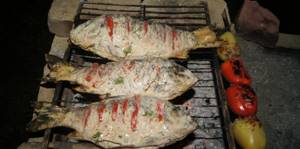
Process of growth and reproduction
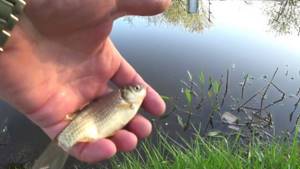
The spawning of crucian carp directly depends on external environmental circumstances. It often begins in early June or in the last days of May.
During this period, the crucian carp stops feeding, so going for such a trophy will be useless.
Fish often spawn near the shore, next to aquatic plants. Due to the fact that females lose all caution during this period, it is often possible to catch them even with a net from the shore.
How long does the spawning period last? It is impossible to give a definite answer to this question, because it varies depending on the region.
Among other things, it differs based on the type of fish. As a rough guide, the golden subspecies spawns at a temperature of 18C, while the silver subspecies requires approximately 15C. Females can produce about 200,000 eggs, approximately 1 mm in diameter. Embryos appear around day 4, 3-4 mm long.
Initially, they receive nutrients from the reserve of the yolk sac, and soon over time they begin to absorb plankton. In a good food situation, by autumn they can reach up to 5 cm, but no more than 10% of all embryos survive to this size. How quickly will it happen? The development of fish largely depends on the quantity and quality of food, but this story is relevant not only for crucian carp, but for all inhabitants of the reservoir as a whole.
Amazing capabilities of crucian carp
Unlike other fish species, crucian carp can withstand most of these conditions and even more. It can fall into a state of suspended animation when there is a lack of oxygen in the water, buries itself in the silt and remains there in this state for quite a long time: the time can be calculated not in days or months, but in years.
A female crucian carp can lay from 50,000 to 300,000 eggs, most of which may not produce offspring due to unsuitable conditions, and some may simply be eaten by other fish species.
Under certain conditions, the surviving part of the eggs will give rise to fish offspring in the form of small crucian carp, which are practically not protected by anything in the first days of life. They appear 2-3 weeks after the eggs have been laid and fertilized. During this period, quite a lot of crucian carp fry die. The first year or two is very difficult for him, after which it is easier for him to survive until puberty, which occurs in the 3rd or 4th year of life. In two years, if there is enough food, he can gain weight from 200g to 300g and may no longer be afraid of most of his hunters. But this is exactly the weight that fishermen love very much and are not averse to having such crucian carp as a trophy.
Habitat halo

In a situation where there are too many golden individuals in a reservoir, and there is no other similar living creature there, then it grows even worse and over time may even begin to decrease in average size. In this case, the silver species is more relevant for breeding due to its vitality , regardless of habitat.
In the natural environment it is almost impossible to find individuals weighing more than 1 kg. By about three years, they gain about 250 grams, which is almost 2.5 times more than the weight of a golden one at the same age. Wild individuals are often used as donors for breeding aquarium fish. Thanks to them, it is possible to obtain unique sizes, colors and shapes.
That is why these fish are the subject of various dialogues and practical studies every year. Fish farmers from China and Japan were able to completely develop a separate species of aquarium goldfish, for which goldfish were originally taken.
The fish can be found in the Far Eastern region of Siberia, which is actively grown along with other, more valuable species. It is mainly used for catering establishments as a sought-after raw material. According to the generally accepted classification, crucian carp is from the carp family, and within its group it belongs to the genus carp. In addition to Europe and Russia, it can be found in smaller quantities in Africa and North America.
TOP-5 largest crucian carp in the world
Of all the caught and registered giants, we can make the following list of the largest individuals of this fish:
- No. 5 - belongs to Yuri Skvortsov, who in 1998 in the Pskov region caught a crucian carp weighing 3 kg.
- No. 4 – in the spring of 2021, a specimen weighing 3 kg 250 g was caught on the Dnieper.
- No. 3 – in the summer of 2003, an individual weighing 4 kg 120 g was caught in Austria.
- No. 2 – in the fall of 2010, a golden subspecies weighing 4 kg 300 g was caught.
- No. 1 is a record set by a resident of Russia Igor Ivanov. A specimen of the golden subspecies weighing 5 kg 450 g was caught on Lake Osyno (Pskov region).
Article on the topic: Catching pike with a wobbler, wiring technique
How to catch?
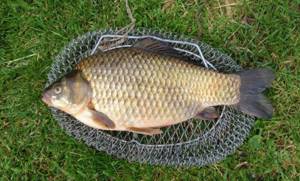
This is a fairly popular and important fish for every angler. It is not only actively bred, but also hunted as a trophy.
The optimal tackle for this fish is a float rod. Some take into account that crucian carp is also good for “donka”, but if you take into account the habitat of crucian carp, then it will not be suitable.
Expert opinion
Valery Andreevich Sizov
Professional fisherman with 35 years of experience
IMPORTANT!!! For fishing, it is best to choose early evening or late morning. Large fish were most often caught almost immediately after sunset, because at this time they actively begin to look for food.
If it is convenient, you can fish from a boat; for those who do not have such an opportunity, you can get used to doing it from the shore. It is important to find aquatic vegetation near which this fish can often be found. The best fishing will be in places where there are windows of open water in the vegetation. Experienced fishermen first send the bait there.
As for bait, you can use almost any type:
- semolina;
- worm;
- pearl barley;
- maggot;
- bread;
- bloodworm.
Experts also recommend using fertilizing. Moreover, if you don’t have the time or desire to do it yourself, it’s best to purchase ready-made fertilizer for crucian carp in a specialized store.
Despite the confident bite, it is best to hook as boldly and as quickly as possible. The diameter of the line is needed 0.3, and the hook should be 5-6. You need to keep it near the bottom.
Winter fishing
Rarely does a fisherman go out for this particular fish in winter, since there are more predictable options. This is due to the fact that the behavior of crucian carp during this period is unpredictable based on the reservoirs.
Sometimes it can be caught in the same body of water in any month of winter, but not the next year. This is especially true for small reservoirs, where it hides in silt for the winter.
It is necessary to understand that fish actively react to changes in atmospheric pressure, which means that if it decreases, you can’t hope for a good bite, and vice versa, if it increases, you can be sure of returning home not empty-handed.
The best time for winter fishing will be sunny, slightly frosty days without wind. The fish stop feeding during severe frost or snowfall, so during this period there is no hope of catching one. Despite the fact that winter fishing is very unpredictable for this type of fish, if there is a bite, then often only large specimens are caught.
This is due to the fact that young fish hide in the mud, while large fish continue to look for food. It is best to start fishing in the first two months of winter, while in February there is a decline in the bite.
Types of crucian carp
As far as we know, two types of crucian carp can be found in our reservoirs: golden and silver . Golden crucian carp prefers reservoirs with stagnant water, and silver crucian carp can live anywhere: in rivers, lakes, ponds, stakes, etc. Even small, artificial “diggings” somehow become populated with white crucian carp over time.
Red crucian carp can live, if it is not caught during this time, up to 10, 12 years , gaining a weight of 5 kg during this time and reaching a length of about half a meter. As a rule, inveterate “crucian carp fishermen” know the habits of this fish well, since they give preference to catching golden crucian carp, which is considered tastier than its silver counterpart. To catch such a handsome fish, appropriate baits and attractants have been developed. In this case, the habits of the red crucian carp are used, which moves around the reservoir using its “paths”. Every fisherman has a great desire to catch red crucian carp, which, weighing about half a kilogram, resists very seriously. They also say that he is much smarter than the white one, therefore, he very rarely falls for the bait.
Silver crucian carp lives no more than 10 years , reaching a weight of about 1-1.5 kg. Being in the same reservoir with red crucian carp, it gradually displaces it and takes a dominant place. Most likely, this is due to the fact that silver crucian carp is more tenacious and prolific, while eating its golden brother. At the same time, it is able to live in very muddy water. Sometimes you just wonder how white crucian carp can live in such a reservoir, with such muddy (sometimes green) water, and in large quantities at that.
As a comparison, we can say that the beluga can live up to 100 years. Fish such as carp, catfish, and sturgeon can live up to 50 years, and smaller fish can boast a life expectancy of about 10-15 years.
From the above we can conclude: the larger the fish, the longer its life.
fishingday.org
The common crucian carp has a tall body, a small head, a long dorsal fin, and no antennae. The dorsal and anal fins each have one powerful serrated spine. Its back is dark brown, its sides are copper-red or golden, and its belly is light. Under favorable conditions, golden crucian carp can grow up to 40-45 cm in length and 3 kg in weight. The usual sizes are much smaller - up to 30 cm and 250-400 g. Golden crucian carp has extremely high vitality, surviving in conditions when all other fish die from unfavorable conditions. In overseas reservoirs it is often the only representative of the ichthyofauna. For the winter, crucian carp, as a rule, are buried in silt, sometimes to a depth of 70 cm, and remain alive even when reservoirs freeze to the bottom, restoring their vital functions in the spring. Does not make large feeding or spawning movements. Only when it gets colder does it move from shallow waters to deeper places. The food of adult fish is higher aquatic vegetation and, to a lesser extent, algae. The feeding intensity of golden crucian carp is clearly seasonal, since the greatest feeding activity occurs in the summer, and in winter its feeding stops.
| crucian carp - one of the most common and widely known fish. It is found almost everywhere, preferring heavily overgrown stagnant lakes and ponds with fairly warm water. In rivers it lives in creeks, bays, oxbow lakes with a muddy bottom and an abundance of aquatic vegetation. Few in reservoirs. Silver crucian carp is often found in running water - in rivers with weak currents. Crucian carp, especially golden carp, is a very unpretentious and hardy fish. It is able to live with such a low content of oxygen dissolved in water like no other fish, with the possible exception of tench and loach. Golden crucian carp remains alive for a long time in the silt of dry ponds, burrowing to a depth of more than half a meter. He doesn't fall asleep in a basket of wet grass for quite a long time. Silver crucian carp is inferior in endurance to golden carp, but it is also much hardier than many fish, including carp. The usual weight of crucian carp is 100-200 g. Individual individuals, most often silver crucian carp, often reach a kilogram weight. And in the regions of Siberia and the Far East there are reservoirs where crucian carp weighing several kilograms can be found. At one time in the Far East, I was lucky enough to catch a crucian carp weighing 2 kg 400 g on a bottom fishing rod. In lakes and ponds with little food, when overpopulated, the crucian carp becomes smaller and even at an advanced age does not exceed 10 cm in length. But in most reservoirs it finds a sufficient amount of food and growing quite well. In reservoirs where there are predatory fish, crucian carp are always larger. The crucian carp feeds on a variety of small aquatic animals, which it extracts from the silt or collects from the surface of the bottom and underwater objects, as well as soft parts of plants. In the diet of silver crucian carp, plant food and plankton make up a larger proportion than that of golden carp. Crucian carp is a heat-loving fish and is of interest to anglers only in the summer. Golden crucian carp are more sensitive to cold than silver crucian carp. In September it ceases to lead an active lifestyle; in October it lies down for the winter, burrowing into the silt in deep areas of reservoirs. Silver crucian carp in the fall still remains active for a certain time and in general, as I am convinced, is not afraid of cold water. I had to catch it even when ice edges were already forming off the coast. In the summer, it was often possible to catch large specimens of crucian carp from a depth of 4-5 m in places where springs emerge. Only in November-December does he finally cease to be interested in food and hibernate. And in the southern regions of the country, according to available information, they catch it from the Ice even in January during persistent thaws. This suggests that silver crucian carp, unlike its golden counterpart, obviously does not bury itself in mud for the winter. Many people are interested in crucian carp fishing. And in a number of regions of the country, fishermen have to catch only it, since in local reservoirs for tens or even hundreds of kilometers in the area there are no other fish worthy of the attention of anglers. Interest in crucian carp is manifested not only for its high taste when fried. Catching it is interesting and exciting in its own way. Crucian carp, especially large ones, are a rather cautious fish, and catching them with rough tackle rarely brings success. He prefers to bypass a fishing rod with a thick line that is clearly visible in the water. To be convincing, I will give an example from my practice. When fishing for crucian carp in a reservoir with very clear water, I and many other anglers that day had to be content with a very modest catch. But one fisherman’s catch aroused not only some envy, but also admiration. As I later became convinced, the secret of success lay not in a well-chosen place, not in complementary food or bait, but in the tackle, more precisely, in a fishing line with a diameter of 0.17 mm, painted blue. In reservoirs where the water is not very clear, it is better to use yellow or light yellow fishing lines. When fishing for large crucian carp, which almost always takes the bait from the bottom, the fishing line should be painted to match the color of the ground. When fishing for crucian carp, float rods are considered the most popular. It is advisable to have a light rod, 4.5-5 m long. Telescopic rods are very good for such fishing. They are long enough, light and have suitable flexibility. For composite bamboo rods, lightweight three-legged rods with a flexible and fairly strong third leg should be used. To catch crucian carp, many anglers use hooks No. 4 or No. 5. When fishing with a worm, it is better to use hooks with a long shank, and when using. attachments of plant origin - light (nickel-plated) with a short fore-end. Some fishermen tie an additional one on a short leash 15-20 cm above the main hook. With a good bite, the second hook justifies itself, but with a bad bite, it rather gets in the way. Using a jig when fishing with a regular float rod increases the number of bites. The best jig, as practice has shown, when used as a worm and bloodworm attachment is a medium-sized silver-plated “pellet”. The same red “pellet” has worked well with baits of plant origin. Since crucian carp has a well-developed sense of smell, after dyeing the jig, to eliminate the smell of nitro paint, you need to soak it in sunflower oil for some time. Small floats made from bird feathers are good for catching crucian carp. The float will be more sensitive if it is attached to the fishing line at one lower point. When using jigs, the size of the float feather should be such that only a small part of it protrudes from the water. Then even a light touch of the fish on the jig is transmitted to the float, and it will either sink or float up. It is better to paint the float black. When fishing from the shore, many anglers use a spinning rod as a bottom fishing rod to cast baits long distances. The fishing line for such gear should be 0.3-0.4 mm thick. It is equipped with two hooks and a sinker. It is very important to skillfully select a sinker. Then the throw will be accurate and the line will not get tangled. The first hook is tied no closer than 15 cm from the sinker. The maximum thickness of the leashes is 0.2 mm, and the length is no more than 15 cm. A light metal ring with a diameter of 45-50 mm is used as a bite alarm. It is tied to the first throughput ring from the tulip with a piece of fishing line 4-6 cm longer than the end of the spinning rod. When casting, the end of the rod tilts and the ring is dropped onto the fishing line. It fixes the tension of the fishing line, and even a weak bite becomes noticeable. When hooking, the ring returns to the rod. In spring, summer and autumn, crucian carp fishing has its own distinctive features, knowledge of which greatly influences the success of fishing. After the reservoir is completely opened and the water warms up slightly, the crucian carp begins to lead an active lifestyle. At this time, it stays mainly on well-warmed mud flats with aquatic vegetation at a depth of 1-2 m. In the spring, crucian carp have the best bite. Gaining strength for spawning after a winter hunger strike and restoring it after it, it bites confidently, and sometimes greedily. At this time, a worm and bloodworm are the best baits for catching it. As the reservoir warms up, more and more vegetation and aquatic organisms appear in it. By mid-June, in most areas, crucian carp no longer lack food. The presence of sufficient food, which it does not need to search intensively for, largely determines the behavior of this fish. A sedentary lifestyle leads to the fact that by mid-summer the bite of crucian carp becomes capricious, and the larger the fish, the more finicky it is. The crucian carp, like all carp fish, does not have a stomach. Its feeding occurs periodically, but much more often than in fish with a developed stomach, the time when crucian carp does not feed under favorable weather conditions is 4-6 hours. In small crucian carp such pauses in feeding are insignificant. For this reason, he bites more often and, therefore, gets caught more often. On warm and quiet summer nights, especially during the full moon, crucian carp feed mainly at night and rarely during the day. Changes in the weather have no more effect on crucian carp than on other fish. With a sharp cold snap and rising temperatures, the bite noticeably worsens. It improves significantly on warm cloudy days with light summer rains and thunderstorms. There are other factors that anglers should pay attention to. It is known that in summer the diet of crucian carp is dominated by plant foods and when fishing, it gives preference to baits of plant origin. Such attachments include bread, preferably black, porridge, dough, steamed wheat and oatmeal. Many fishermen mix various odorous substances and even lipstick into baits. This gives a certain positive effect. I knew one fisherman who very successfully caught crucian carp even in July using pellets of black bread, to which he added a little sunflower oil fried with onions. To prepare this attachment, it is better to take the crumb from the top crispy crust. It is more flavorful and attracts fish better. A nozzle made from white bread crumb mixed with sour cottage cheese has proven itself well. It attracts crucian carp with its specific smell. The cottage cheese for this attachment is placed in a sealed container in a warm place for a week. It is not difficult to prepare another quite effective attachment. Pour a glass of water into a small saucepan, dissolve four teaspoons of sugar in it and add one third of a glass of millet. Cook the porridge over low heat with frequent stirring until the grains are completely cooked. The cooled porridge is thoroughly kneaded with a pestle. Add flour, crushed cookies (two or three pieces), two teaspoons of sunflower oil and knead the bun. The nozzle is ready. In the summer, it was with this bait that I often managed to catch the largest crucian carp. Having a good sense of smell, crucian carp easily finds bait that emits an appetizing aroma for it. However, odorous substances should be used carefully and in very small quantities. I remember two cases from my practice. In the first case, the faint smell of mint, accidentally transferred with saliva to the pellets of bread after I ate mint gingerbread, had a positive effect on the success of fishing. In the second case, the crucian carp’s bite stopped after using a bread bait flavored with a decent portion of mint essence. On frequently visited reservoirs, where individual fishermen, unfortunately, literally feed the fish with food products from our table, catching crucian carp using the baits described above does not always bring success. In such reservoirs, crucian carp are more willing to take dung worms, dragonfly larvae, maggots, and crayfish meat. Feeding crucian carp before and during fishing is always useful, but in reasonable quantities. Before fishing, it is enough to throw a small handful of crushed cake, soaked crusts of black bread or well-steamed grains of wheat or oatmeal into the water. During fishing, the bait is periodically thrown in small portions to the floats. The bait should only attract fish and stimulate its appetite. Even in grassy areas, the bait should be lowered as close to the bottom as possible. Usually experienced fishermen keep it 3-5 cm from it. On hot sunny days, when crucian carp often walk in schools on top, the bait is kept 10-12 cm from the surface of the water. When fishing in grassy areas, it is better to use a jig. It is not only more catchy, but also much less likely to get caught on plants compared to a hook, and the hook is easier to detect. You can fish with a jig from the shore or from a boat at windows in grassy areas. For such fishing, a light rod of medium length (2.5-3 m), equipped with a side nod, painted in a bright color, and a reel is suitable. With its help, the length of the fishing line is changed when fishing and when landing fish. Many fishermen have more than once noticed air bubbles coming from the bottom of the reservoir. They are picked up, rummaging in the silt, by carp, tench, bream and crucian carp, but in purely crucian waters they belong only to him. It is useless at this time to offer him a bread ball or other plant-based attachment. But he can readily take on bloodworms or a small dung worm. In summer, large crucian carp are successfully caught in deep places with holes and depth changes. Early in the morning, in most cases, it does not bite in such places. When crucian carp return from the shallows to rest, they are practically not interested in food. But after a few hours, most often around 8 o'clock in the morning, he begins to develop an appetite. It has been noticed that he almost does not take worms, bloodworms and other baits of animal origin at this time. Experienced crucian fishermen always prepare several baits from dough, bread and cereals for this kind of fishing. And if the crucian carp likes any of them, then success is guaranteed. In autumn, crucian carp are searched for at the exits of pits and in the pits themselves. He wakes up late at this time, only at 10-11 o’clock does he make himself known with weak, barely noticeable bites. The bite mostly happens on fine days. The bite of crucian carp is clearly visible and pronounced in the spring, when it is hungry. The float without hesitation goes under the water or to the side, less often lies on its side. At this moment you need to hook. The hook should be short and not very strong. A more sweeping hook is done when fishing with a spinning rod converted into a donkey. In summer, large and medium-sized crucian carp take bait like bream or tench on a bait lying on the bottom. The float, swaying, begins to lie on its side. At the moment when the float completely collapses, you need to hook. As I have seen, there is no need to wait for the float to move to the side or begin to sink. If you are a little late, the crucian carp, as a rule, manages to spit out the bait. Large crucian carp are stubborn when fishing, and if the fishing line is thin, don’t rush. Bring it in carefully, without loosening the line. It is better to take large specimens from the water using a landing net. This is what crucian carp is like! In my fishing practice for several years I had to do only err fishing. And I realized that crucian carp is not such a capricious fish when it comes to biting, as is often written about. You just need to know his way of life well, his skills. look for it and correctly use gear and baits depending on the time of day, year and fishing conditions. Published according to the publication: “Fisherman Club” No. 49, 1989. |
| crucian carp |
| Home Home Farm Garden and Vegetable Garden Equipment Construction Business and Life | |
| Home Farm / Fish Farming. Fish farming Crucian carp. Breeding crucian carp In fresh water reservoirs you can find gold and silver crucian carp. Crucian carp meat is not inferior in taste and nutrition to carp meat, but crucian carp can be grown in ponds that are unsuitable for breeding other fish. True, crucian carp grows much slower than carp, but with good care, silver crucian carp can gain a weight of 250 g in two years. Crucian carp are resistant to many diseases that are destructive to carp, especially rubella and branchiomycosis, a fungal disease that affects the gills of fish. And if you add silver crucian carp to the carps and raise them together, then the incidence of the disease in the former will decrease. Apparently, crucian carp release substances into the water that have an adverse effect on rubella viruses and fungal spores, but it is possible that these substances have a direct effect on the carp’s integument and increase immune defense. This interesting phenomenon requires careful study. Golden crucian carp Silver crucian carp Common crucian carp (golden) have a tall body with a small head. The back is yellow-brown in color, and the sides are golden with a copper tint. The dorsal fin is long, slightly convex, the caudal fin has a small notch. The last branched ray is slightly serrated. Mouth without antennae. The pharyngeal teeth are single-rowed. Golden crucian carp love ponds with muddy bottoms. Golden crucian carp is an exceptionally hardy fish and in some reservoirs it can be the only representative of the fish mass, since it is able to live in swampy acidic water (pH 4-5) and can easily withstand a decrease in the oxygen content in water to 0.5 m/l. When a reservoir freezes to the bottom in winter, or when it dries out in hot summers, crucian carp burrow into the silt to a depth of 0.4-0.6 m, and sometimes deeper. Crucian carp reach sexual maturity at the age of two to four years. Fertility - 200-300 thousand eggs. Spawning occurs in portions (usually three or four, and sometimes five portions), starting from the second half of May until July at a temperature of 14-18 ° C, with breaks between throwing each portion up to 10-5 days or more, depending from climatic conditions. During herd spawning, fish noisily splash in shallow water in aquatic thickets, laying sticky eggs on underwater vegetation and the roots of coastal plants. The caviar is small, about 1.5 mm in diameter, and can be of different colors: yellow, gray, greenish, etc. Despite the fact that individual goldfish can reach a length of 45 cm and a weight of 2-3 kg, nevertheless, this fish grows very slowly. In the first year, crucian carp can reach a length of 5-8 cm and a weight of 10-15 g. And only in the fall of the fourth year they will reach a length of 17-19 cm and have a mass of 200-250 g. At the age of 8-10 years, most crucian carp specimens weigh 1-1.5 kg. If you feed them, they grow faster and in the first year they can reach a weight of 15-20 g, and by the second year 100-150 g. Crucian carp feed both in thickets and in open areas, at the bottom of the reservoir and in the water column. Goldfish feed mainly on zooplankton. It also consumes plant foods, small forms of chironomid larvae, as well as various feed mixtures. Zoobenthos plays the main role in the nutrition of golden crucian carp (adults). Silver crucian carp. These fish have an angular body shape, a black back, silvery sides, sometimes with a golden tint, and a silvery belly. The scales of silver crucian carp are large and rough. The anterior, non-branched ray of the dorsal and anal fins has 10-15 coarse teeth. Mouth without antennae. Sexual maturity is reached at the age of 3-4 years. Fertility is almost the same as that of ordinary crucian carp - 200-400 thousand eggs. They spawn in batches during the same period as golden crucian carp. However, a herd of silver crucian carp usually consists of only females, and their eggs are fertilized by male gold crucian carp or other males of the cyprinid breed. The fact is that the egg of silver crucian carp already carries a double set of chromosomes and it does not need to merge its nucleus with the nucleus of the sperm. The sperm, penetrating the egg, only activates it, but the male chromosomes do not take part in the further development of the body. Only females emerge from the eggs again. This method of reproduction is called gynogenesis (a special form of reproduction is the birth of females). However, if the food supply deteriorates, as well as if the reservoir is overpopulated with fish, males may again appear in the crucian flock, the number of which will reach 50% or more. The presence of pike perch or pike in a reservoir will prevent its overpopulation by silver crucian carp, which in turn will make it possible to better provide fish with food. Silver crucian carp grow faster than their relatives. For example, in some southern regions, two-year-old silver crucian carp weigh 250-400 g, in the middle zone - 150-250 g, and in the northern regions - 120-200 g. The growth of crucian carp, like other fish species, mainly depends on the availability of food. Therefore, it is no coincidence that in reservoirs with a sandy bottom, the growth of crucian carp is much slower than in ponds with a muddy bottom, rich in the larvae of insects, mollusks and other small animals. With a decrease in the food supply in a reservoir, regardless of the region, the weight of two-year-old crucian carp can be significantly less - 75-120 g, and sometimes even less. The live weight of silver crucian carp at the age of 5-6 years is 1-1.5 kg. At the same time, there are individuals 40-45 cm long and weighing 2-2.5 kg. The planting density of one-year-old crucian carp in a reservoir is 1-3 pcs. per 1 m2. With plenty of food in the middle zone, crucian carp in the fall can reach a weight of 150-300 g. Crucian carp weighing about 300 g are considered marketable. The “menu” of silver crucian carp is the same as that of gold crucian carp, but, in addition, they are able to eat small animals that live in the water. To feed crucian carp, mixed feed, grain, grain waste, seedings, bread, boiled potatoes, etc. are used. Silver crucian carp are less hardy than gold crucian carp, and therefore die when the reservoir freezes strongly. | |
| © 2014. All rights reserved. Publication of site materials is permitted provided there is a link to Rural Life | |
selskaja-zhizn.ru
Expert opinion
By asking professional fishermen and specialists in this field about how much crucian carp can grow, we managed to collect interesting information. On average, this type of fish lives 10-12 years. If we take ideal conditions for it, then crucian carp can reach 5 kg and about 0.5 meters in length.
In their natural habitat, fish rarely reach such sizes. Often in overpopulated reservoirs with a small amount of food, individuals of 5 years reach no more than 200 grams. For crucian carp to grow actively, it requires the following conditions:
- a small number of individuals in the reservoir;
- the presence of holes, dumps, silt, so that he can sit there if danger arises or bad conditions arise;
- oxygen balance above 4 mg/l;
- a lot of underwater vegetation.
Paradoxical as it may seem, quite large individuals have been spotted in those reservoirs where pike and perch are found, which are a direct threat to it. Due to the presence of constant danger, those crucian carp that survive try to move as much as possible and lead an active lifestyle, which in turn requires more nutrition. Among other things, predatory fish also help solve the problem of overpopulation of small fish in the reservoir.
We recommend that you read additionally:
The larger the fish, the longer its life span. Regardless of how old the caught crucian carp is, it is always a desirable fish for any fisherman or housewife who chooses it in a fish store. Now you know exactly how quickly crucian carp grows. If you liked the article, leave a comment. Thank you for your attention!
We also recommend reading very useful material about the lifespan of crucian carp.
Stages of life of crucian carp
- Egg stage
- lasts 2-3 weeks from the moment of spawning. During this time, the embryo develops to the point where it can begin to swim. True, most of the eggs - and the female lays from 50 to 300 thousand of them - die at this stage. They are eaten by the inhabitants of water bodies or they are carried to areas of the water area that are unsuitable for them.
- Early fry
- 1-2 months after hatching from the egg. At this stage, the crucian carp is also very vulnerable and becomes prey for literally any predator. But if he survives this stage, he will only continue to grow and gain weight.
- Immature crucian carp
- after 2 months and up to the first 1.5-3 years. During this time, the fish manages to fatten up to 300 grams, if weather conditions and the reservoir allow. And the older and larger she is, the less afraid of predators she will be, the more attractive prey she will become.
- Mature crucian carp
- from 2-3 years it is a male, from 3-4 years - a female. The time of entry into reproductive age depends on the specific living conditions of the fish in a particular body of water. From this time on, the next stage in the life of crucian carp is death - both natural, from old age, and as a result of being caught or eaten by a predator.
Above we wrote that there are 2 types of this fish. Namely golden carp and silver. Let's briefly look at each of them, especially since both of them are found in our reservoirs and it is quite possible to use another bait.
